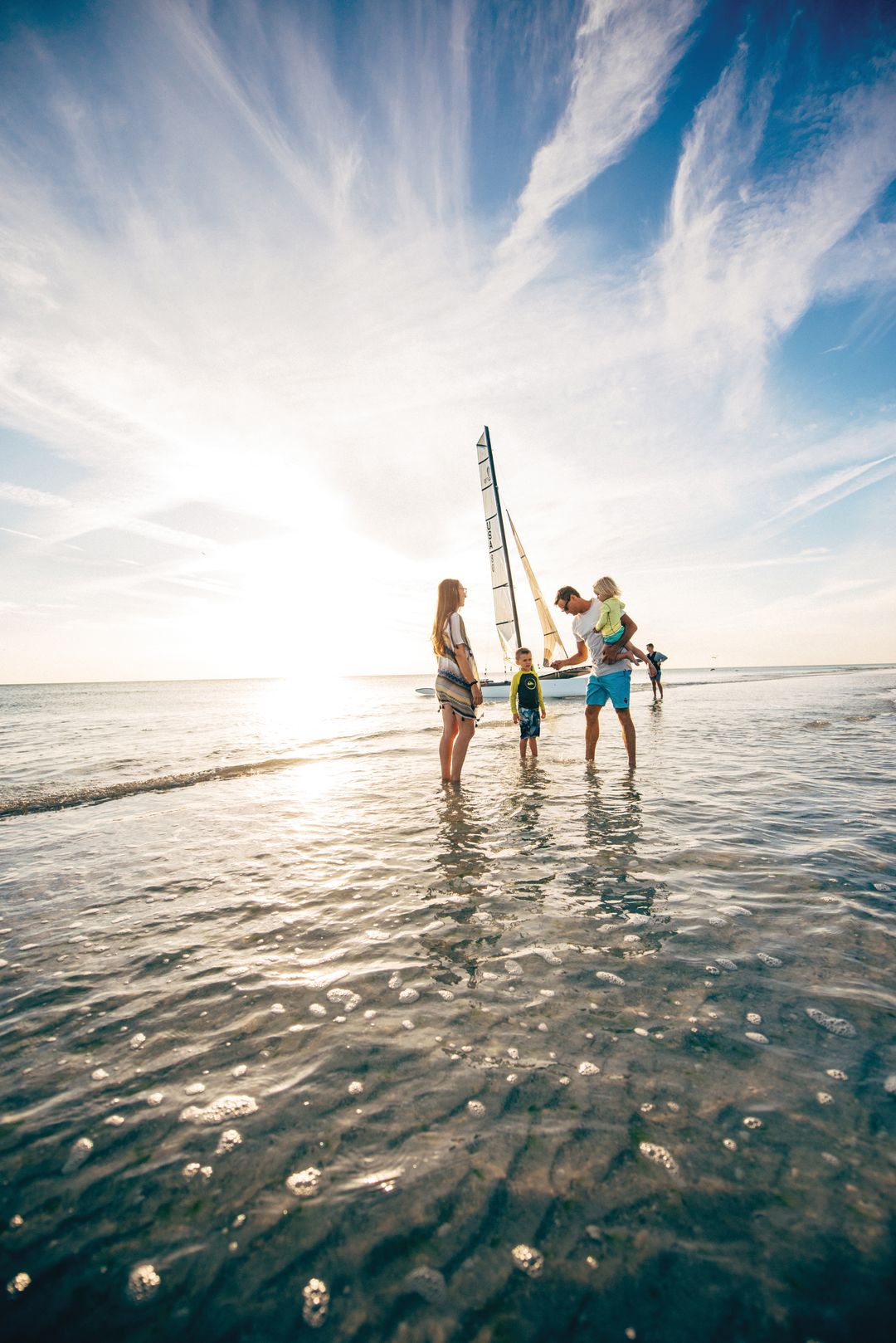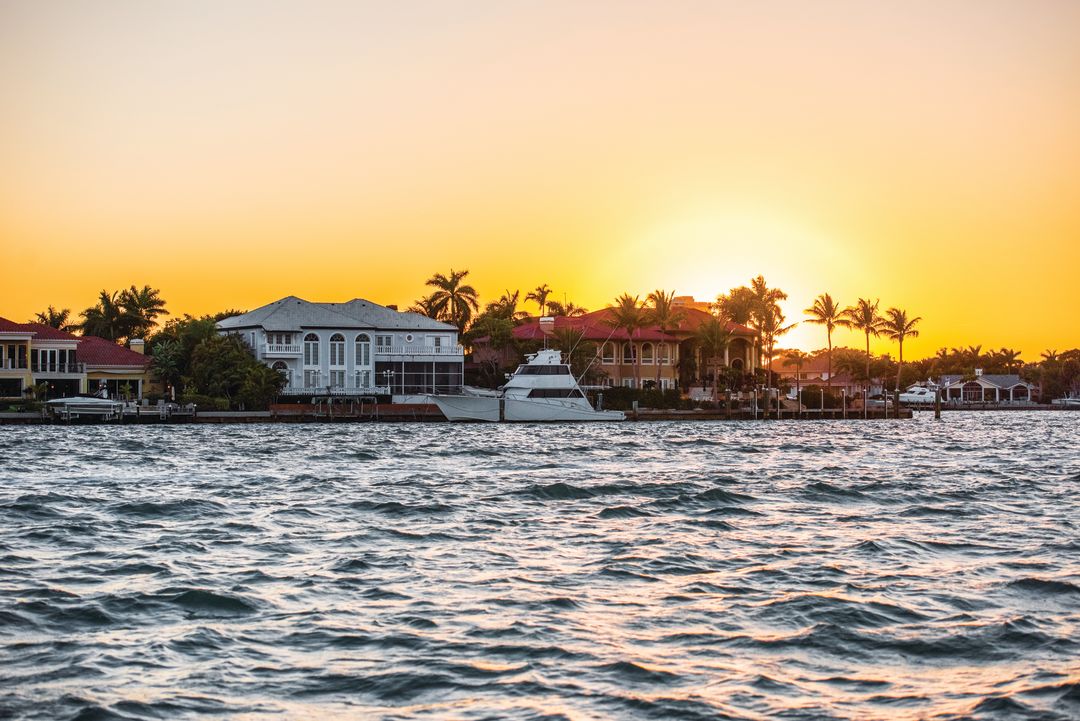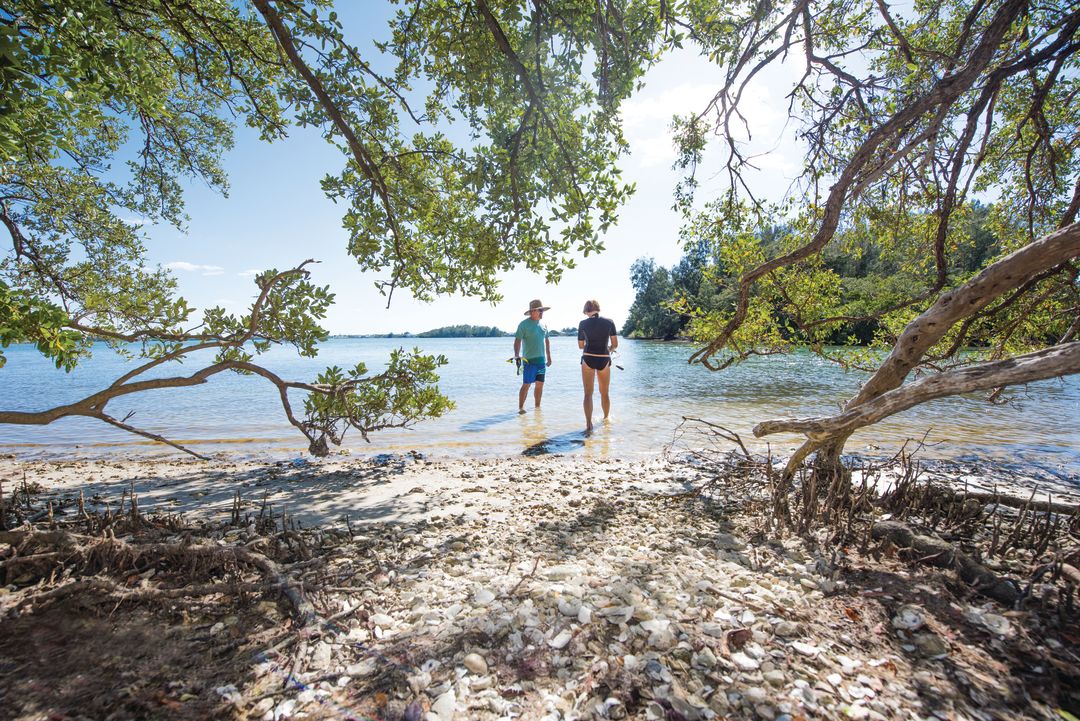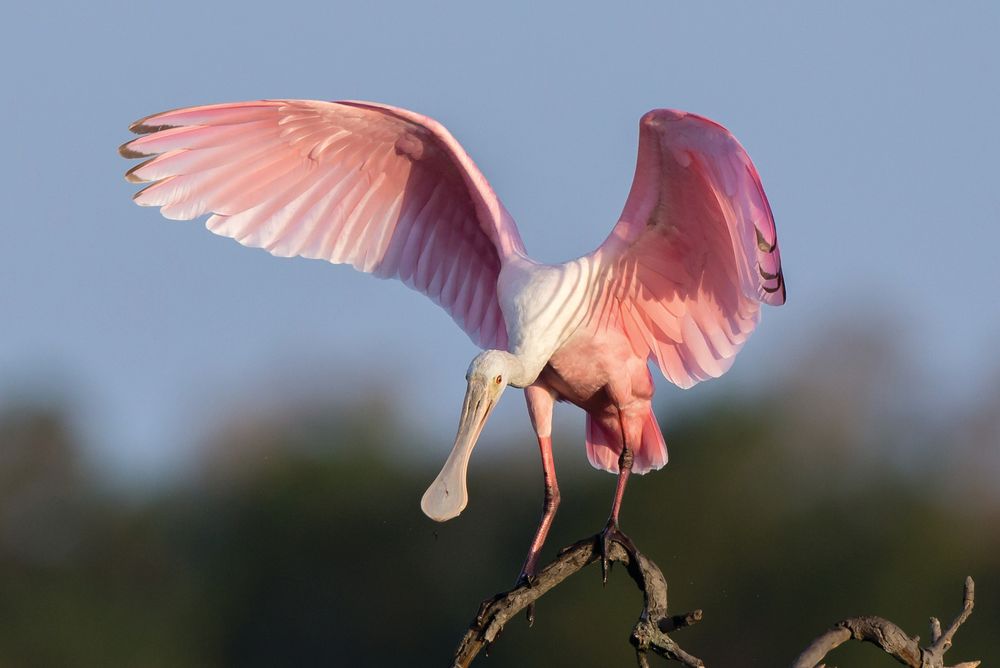
Your Guide to Boating in Sarasota
There must be meteorological reasons why the best sunsets happen in clumps during the spring and fall in Southwest Florida, but I don’t think about that as I relax on my boat anchored near the mouth of Big Pass and watch the sun flit through the colors of a rainbow and sink into the Gulf of Mexico.
For most of the boaters near me, that’s it. Sun’s down. End of show. They pull anchor and hustle home during the half-hour before the day fully surrenders to the night.
Twilight to me is just intermission.
I flip on my navigation lights and idle in, my bow aiming toward downtown’s bayfront. A different sort of light show starts flashing in front of me. Streetlights illuminate Bayfront Drive. Inside all those condominium units, owners flip on light switches until the buildings resemble box-shaped Christmas trees. On any given night the lights above and below the John Ringling Causeway shine a different hue into the water; burnt orange, baby blue, cool pink. I don’t know why. And the lights at Marina Jack are the bright center of the show.
When I head home, a final light show awaits. My wake stirs up a briny phosphorescent foam, a green-white churn filled with a multitude of glowing, microscopic organisms called bioluminescent plankton. The reality is magical enough, but I like to joke to my passengers that I’m slicing through the water releasing some of the sunlight that got trapped in the water that day.
Unlike a sunset over the Gulf, the light show along the bayfront and in my churning wake cannot be captured by a camera. You have to see it for yourself. And to do that you need to be in a boat.
Boaters who ply Sarasota Bay share a special bond. It is not one of conceit because we know what every single part of a boat is called (most of us don’t). It is not mastery, thinking we know so much about area waters that we will never run aground (most of us do). Nor is it guilt because thoughts of being on the water have tempted us to play hooky (most of us have succumbed).
Instead, we share a great secret. Sarasota Bay is a huge watershed of amazing places and experiences—tidal sandbars, seagrass meadows, isolated beaches, bird rookeries, spoil islands, wide-open spaces, kayak trails, fishing spots and glamorous vistas dotted with grand mansions. Owning or renting a boat, canoe, kayak, sailboat or personal watercraft allows you to explore and enjoy them all.
“To live here and not have a boat means you are missing out,” says Jamo Powell, a former commodore of the Bird Key Yacht Club. We’re blessed with good weather and some of the best, calmest boating waters in the country, Powell says, thanks to geography—and engineering. In the 1950s and ’60s the U.S. Army Corps dredged the Intracoastal Waterway (ICW) between the barrier islands and the mainland, allowing boaters quick access to deep water in the bay and a multitude of experiences, from downtown’s urban amenities to funky little waterfront restaurants and tangled mangrove tunnels. “There are plenty of interesting places to go up and down the ICW,” Powell says. “It is just a great place to be on the water.”
And boating is more affordable than many people realize. Sure, you can find plenty of pricey vessels, but inexpensive canoes, kayaks, rubber inflatables, dinghies and jon boats can also get you on the water. Many local boaters make their passion affordable by sharing ownership of a boat or joining one of several boat clubs that give members frequent access to their fleet. And places to rent watercraft are plentiful.
Boaters like to joke that the best two days in your life are the day you buy a boat and the day you sell it. That leaves a lot of days in between filled with sunshine, laughter, family fun, exercise and reflection. Here’s just a sampling of adventures that await you along the ICW.

Mara and Matt Daniel and their three sons look for treasures in the shallows.
Image: Everett Dennison
Seagrass Snorkeling
A seagrass meadow is an underwater community of stunning landscapes, nurseries filled with the newly born and a dynamic mix of creatures, including predatory fish who feed on the inhabitants. Snorkeling is a great way to appreciate their beauty and the key role they play in the marine ecosystem. You’ll see fish like spotted seatrout, ladyfish and pinfish that are on the hunt for the smaller species, while at the same time being hunted from the sky by sharp-taloned ospreys and long-billed pelicans. It’s exciting to see a cormorant dive under the surface and swim as if it’s flying underwater until it snags its prey with its hooked bill. It’s also a treat when a sea turtle or manatee chomping on seagrass comes into view.
tips Seagrass beds are nearly everywhere where depths are less than seven feet, sunlight is plentiful and waters are clear. Take care not to disturb what you observe. Polarized glasses are a must, reducing glare and making it easier to see and swim over the seagrass without disturbing it. Choose a sandy spot outside of the meadow in which to set your anchor by hand.
Sandbar Exploration
Sandbars appear during low tide, created by currents and waves. Some are like small, permanent islands, such as Sharker’s Island at the east end of Big Pass. No two are the same. Many are party spots, where people pull their boats onto the wet sand, turn up their radios and break out the beach chairs. Others stop at the sandbars to let their dogs run and splash. And some anchor next to large sandbars such as Sharker’s, which is usually visible but slightly underwater, to practice skimboarding. Boating around the bay discovering sandbars and seeing what people do on them can make for an interesting day.
tips Most sandbars are in the vicinity of Sarasota Bay’s inlets, especially east of where the channel meets the Gulf of Mexico. One exception is a sandbar that formed outside of Longboat Pass and has stuck around long enough to be named Beer Can Island. Several others can be found along the northern edge of the deepwater channel inside Big Pass.

Image: Everett Dennison
Luxury Home Tour
A spectacular collection of homes lines local waters, from architectural treasures to extravagant mansions owned by the rich or famous—occasionally both. The best views of these homes are from the water, and my visitors love puttering along at the required idle speed to take a gander at the grandeur. The backside of a waterfront home is where the action is, and some feature resort-style (and size) tiki huts and pools, guest houses and ornate lawn and garden arrangements, including hedges trimmed to look like animals. You can also see backyard art, including a realistic, full-size statue of Michael Jordan, a massive beach ball that appears to be stuck halfway into the back wall of a house and original works hung, balanced or cemented into place.
tips Bird Key, northern Siesta Key near the mainland, and along the ICW on South Siesta and Casey Key are great places for home voyeurs, as are the canals cutting through Siesta. To get to canals from the Intracoastal Waterway look not for channel markers (although some canal “exits” have miniature versions of the familiar red or green ones) but for PVC pipes or a similar string of markers sticking out of the water, two-by-two. A line of those is your oft-unsteady path from here to there. Go slow, use high tide to your advantage and trim your engine up to avoid grounding or damaging seagrass beds.

Bill and Susan Linville make a stop on Bob Edwards Island.
Image: Everett Dennison
The Middle Grounds
The Middle Grounds are one of the most reliable fishing spots in Sarasota Bay. They cover a large area to the north and east of the channel leading to New Pass, where a mix of seagrass beds and sandy flats proves irresistible to many prized game fish. Spotted seatrout, redfish, pompano, bluefish, snook and cobia are frequently caught at the Middle Grounds, which are frequented by many of Sarasota’s best fishing guides. I like drift-fishing with the wind and using live bait such as shrimp or small pinfish. Others have success with fly fishing or tossing artificial lures.
tips The Middle Grounds are so expansive that there is not one landmark or GPS coordinate that indicates “You are there.” An option is to go online to Google Earth, type in “Sarasota Bay,” move to the New Pass area and zoom in on the obvious patchwork of seagrass and sand. Several bait shops are within sight of the Middle Grounds, including Hart’s Landing on the southeastern corner of the John Ringling Causeway and the New Pass Grill & Bait Shop, and loading up on bait and supplies at either is an excellent opportunity to ask the staff for advice.
Paddle Trails
Sarasota and Manatee counties have long maintained kayak and canoe trails through and around mangrove thickets, some of them shallow streams dug in an effort to help control the mosquito population on spoil islands. Other trails are scenic tours designed to showcase natural and manmade wonders along the route. Whether you go on a designated trail or just paddle around local waterways, you’ll have a quiet, close-up seat on glorious nature. A number of local businesses will meet customers at the locations with kayaks in tow for a reasonably priced day on the water led by a professional guide.
tips Since kayaks, canoes and other boats you can carry can be launched just about anywhere, you can put in very close to the area you want to explore. Sarasota County has nine designated paddle trails along the bay and three more inland; learn more at the Sarasota Paddle Guide at scgov.net.
Watersports World
You’ll give your kids—and yourself—thrills and lifelong memories when you tow them behind your speeding boat on one of the many devices designed today for that purpose, from wakeboards that let them flip into the air over your wake to inflatable rafts in the shape of a couch that hold four people. With all the new options, waterskiing’s days may be over.
tips There’s only one designated watersports area along the ICW in northern Sarasota; it’s the aptly named Skiers’ Island, south of the North Bridge to Siesta. The zone ringing the island allows the speed necessary to pull that rideable banana with six people on top, each appearing ready to fall off at any second. Warning: This can be a dangerous place on weekends and holidays, with every captain charting his own direction. You can also tow people in the open expanse of Sarasota Bay, but be careful— super-charged powerboats regularly barrel along at 60 miles per hour.
Water Picnic
Having a picnic on land is nice, but when you picnic aboard, there is so much less to worry about: no ants or sand in your food, no dog bounding over your beach blanket, no noisy nearby picnickers—in fact, no nearby picnickers at all. Anywhere you care to set your anchor in Sarasota Bay is a great place for a water picnic. You can even meet up with other friends with boats and anchor together, swapping food and conversation. You can pick the time of day to avoid the summer afternoon thunderstorms or what locals consider cold winter mornings. And how often can you say you saw dolphins surface 20 feet away during lunch?
tips Don’t even think about firing up a charcoal grill on a boat filled with gasoline. (Propane grills that fit snugly into a rod holder on the back of the boat can cook a mean hamburger.) Try to do any necessary slicing at home so you’re not wielding a sharp knife when three-foot wake from the 38-foot cabin cruiser that just motored by rocks your runabout. Think plastic, and let your big cooler double as a picnic table, while a paper grocery bag emptied of supplies becomes the trash bin easily disposed of back on land.
Kid-Friendly Fishing Spots
There are places throughout Sarasota Bay where a little guy or girl can almost always catch some type of fish. Boaters have many more options than those fishing from a bridge or pier, including at least eight artificial fishing reefs. And dozens of “reef balls,” which look like large, misshapen pieces of Swiss cheese, have been placed on the bay bottom at the base of markers. The hollow reef structures work just like their big brothers offshore to attract a variety of marine life such as oysters, corals, stone crabs and, most importantly for a family fishing day, baitfish, sheepshead and gag grouper. So grab those easy-to-use Zebco 404 reels, wrap the little ones tightly in life jackets and go diggin’ for some big ‘uns.
tips Several natural kid-friendly places to fish are within sight of the boat ramps in southern Sarasota Bay. The deep grass just outside the mooring field to the east of the Sarasota Sailing Squadron on City Island is a hot spot for pinfish and grunts. The artificial fishing reefs are mostly clustered between the bayfront and the bay side of Lido Key. Their exact locations can be found online here. Reef balls at the base of many of the markers along northern Siesta Key nearest to the ICW are especially good when the tide is moving. The Rose Coker reef in seven feet of water a few hundred yards northeast of the northern bridge to Siesta Key is productive as well.
Scouting Out Spoil Islands
In 1895 the federal government launched an ambitious plan to create an inland waterway from Tampa Bay to Charlotte Harbor to shelter smaller vessels from rough seas in the Gulf of Mexico and to move local products such as citrus and lumber to market faster. The Gulf Intracoastal Waterway was finally completed in 1967. The material dredged up, called spoil, was piled off to the side of the new channel. In time, the spoil settled into islands and became a part of Sarasota Bay’s ecosystem. It’s great fun to stop at a spoil island to fish, swim, picnic and explore. No two are alike in shape, size or elevation, and a hike around some of the larger ones can be a bit of a journey. Along the way, you’re sure to see critters, including raccoons, snakes and salamanders, which probably made their way to the islands by swimming. You never know what you will find on a spoil island. Some years ago, somebody strung a net 100 feet long and 25 feet wide between the trees on Big Edwards Island south of the north bridge to Siesta Key.
tips Many spoil islands are ringed with rocks and oyster beds, making them accessible only to kayaks, canoes and other smaller craft. The 35-acre Jim Neville Marine Preserve in Little Sarasota Bay at the southern tip of Siesta Key contains a number of islands surrounded by shallow water. Motorboats can land at some at high tide, while paddlers can meander through the preserve on a maze of waterways or complete a one-mile loop around the islands, stopping wherever they can clamber ashore. Other spoil islands, including Skier’s Island and Beer Can Island, were made for motor boats.
Metal Detecting
Boat owners into numismatics and treasure hunting can travel to places most others cannot go, like the beach at the former Midnight Pass or sandbars where people with pockets full of change hop out of their boats. Because these spots are seldom explored, there’s a good chance they’ll find enough change to pay for the day’s gas.
tips Gulf beaches are scoured daily by detectorists, but the bay sides of barrier islands, such as the beachy edge found on southeastern Lido Key, are often overlooked. Enough people have explored spoil islands or gone swimming offshore that metal detecting can turn up change or bigger treasure. If nothing else, metal detecting provides some decent exercise, walking along and swinging the coil over the ground hoping to hear the “beep-beep” that means coins, a silver charm or a gold ring.

Roseate spoonbill
Image: Shutterstock
Wildlife Photography
Thanks to the efforts of the Sarasota Bay National Estuary Program and other state and local organizations, the bay is in the midst of a decades-long recovery after many years when pollution flowed in from estuaries, development destroyed seagrass meadows and fish populations thinned. As the bay’s health increases, so do the opportunities for wildlife photography, which exist above, at and below the waterline. Common birds include great blue herons, ospreys, roseate spoonbills, kingfishers and many more. Dolphins surfacing to breathe or working as a team to corral prey in the shallows are daily occurrences. For those quick on the shutter, a mullet jumping out of the water or stingray taking to the air to escape a shark can make a great picture. Tarpon and smaller sharks, like spinners, often fly into the air when hooked by an angler.
tips Signs warn boaters to stay back from Bird Colony Islands in Roberts Bay, but you’re still close enough to photograph the abundant waterfowl that inhabit the long mangrove island. Dolphins often feed near choke-points in the bay, such as where bridges cross over, like the area near the southern bridge to Siesta Key. Trailing anglers can result in some fantastic fish-jumping images. An easy way to shoot underwater is to buy a disposable camera pre-loaded with film, but the quality of those photos can be disappointing. For those willing to take a risk with a better camera, a trick professional photographers use to photograph underwater is to bring along a clean, empty fish tank. One person submerges the tank and holds it steady enough to allow the photographer to hold the camera inside the tank and shoot. And even scanning the water with a finger on the shutter can pay off, sometimes in no time at all.
Secluded, Splendid Midnight Pass Beach
In 1983, Midnight Pass closed after homeowners threatened by erosion pumped sand into the centuries-old inlet. That unexpected consequence sparked enormous controversy—and created the closest thing to a large private beach on public land in heavily populated Florida, outside of a state park. (It’s now a county park named Palmer Point.) You can beach your boat on a sandy strip on the bayside and traverse thin pathways through sand dunes packed with sea oats and little yellow flowers to emerge on a stunning stretch of beach. Despite being down-drift of the slightly coarser sand at Crescent Beach and the mini-pebbles found in the sand at Turtle Beach, the sand at Midnight Pass remains exceptional, soft, white and cool on a hot summer day. It’s a great place for a picnic and swim, a sunset walk, or anything in between, and unless it’s a weekend or holiday, you might have this splendid stretch of shore all to yourself.
tips At the southern end of the Jim Neville Marine Preserve, which is well-identified on numerous signs mounted on dual, telephone pole-like pilings, is what remains of the southern channel of the former Midnight Pass. Turn into it and head roughly northwest. Head toward the sandy strip on the bayside, slide your bow onto the land and set your anchor in the dry sand.